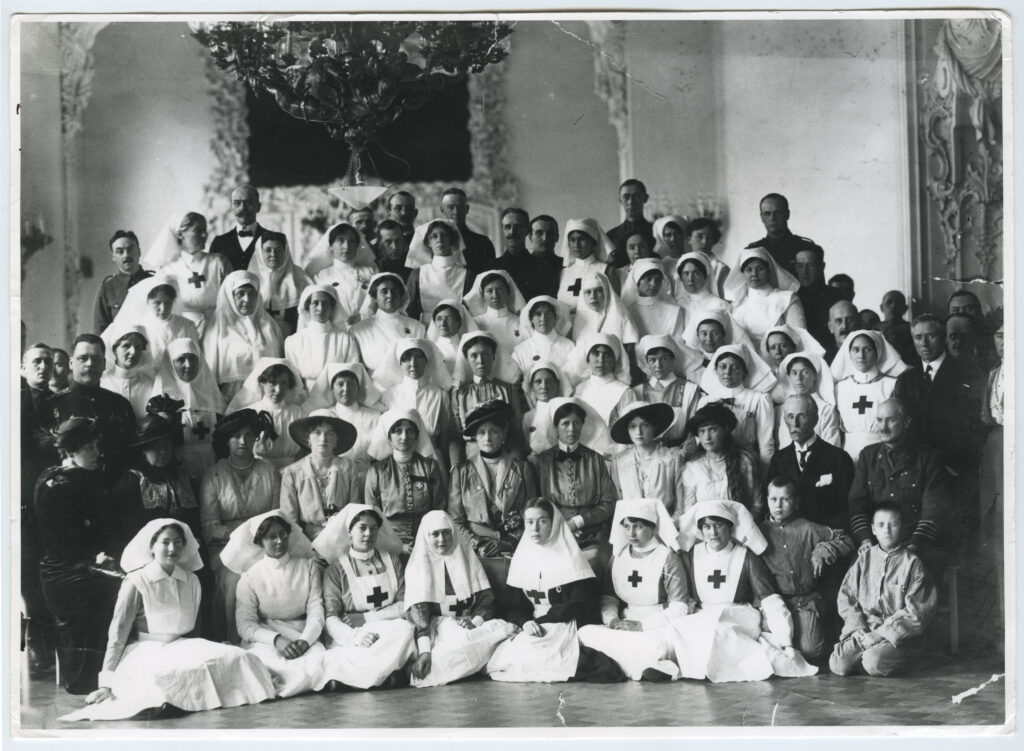Register for free for this event – Click here
Simon Boyd, author of Lady Sybil: Empire, War and Revolution (Hayloft Publishing Ltd, 2017), writes about his remarkable grandmother Lady Sybil Middleton (née Grey)
Simon is speaking at our free online festival at 6 PM on October 16th.
In October 1915 a young English woman left her comfortable life in England to travel to Russia in the middle of the First World War. The young woman was Lady Sybil Grey who happens to have been my grandmother. I am lucky to have been able to write an account of her childhood and formative years, plus her service in Russia and elsewhere, from letters and diaries which came down to me in an old trunk found in my mother’s attic.
Sybil Grey (that is how she signed herself) went to Russia to establish a British volunteer hospital in Petrograd (today St Petersburg). The Anglo-Russian Hospital, established to treat only ordinary Russian soldiers, was Britain’s gift to its Russian ally in World War One.
Sybil was born in 1882 and was one of the five children of Albert 4th Earl Grey and Countess Alice Grey. Her grandfather was Personal Secretary to Queen Victoria. Her great grandfather had been the Prime Minister responsible for the Great Reform Act of 1832. Sybil’s father, Albert, was an MP and later Administrator of Rhodesia, before becoming Governor General of Canada for 7 years before the First World War.

Lady Sybil, in the uniform of the Women’s Legion, 1919.
Aged 33 in 1915, single, brave and determined, Sybil had trained as a VAD (Voluntary Aid Detachment) support nurse and had headed up a hospital at Howick Hall in Northumberland, her father’s country house. She was then chosen to oversee an advance party to set up the Anglo-Russian Hospital in Russia.
Not everyone was supportive. The British Journal of Nursing denounced her appointment and forecast that there would be chaos in the nursing department. In fact, Sybil proved well able to fulfil her role as the hospital’s administrator and representative to the Russian Red Cross and the Imperial authorities in Russia, while the medical practice was handled by a staff of nearly 50 doctors and nurses almost all from Britain. She also proved inspirational when it came to defending her hospital during the Russian Revolution.
She had first to choose a site for her 200-bed hospital and selected a royal palace owned by the Archduke Dmitry Pavlovitch, a young cousin of the Tsar. It had first to be converted since it had no sanitation and its walls and priceless paintings were covered by Arborite board.
She was well connected. She dined with Sergei Sazonov, the Russian Foreign Secretary, and she met the Empress in the Tsarina’s palace. She left a vivid description of their one-to-one meeting:
“She got up and came towards me, dressed as a Nurse. It suited her extraordinarily well and she looked very, very handsome, but utterly different to what I had expected. I expected a cold tragic face with all the life gone out of it. Instead it was a beautiful face full of sympathy and charm, beautiful English and very, very easy to get on with, so much so that it was extraordinarily difficult to remember who she was. But somehow one came away with a heavy heart and thanking God one wasn’t an Empress, especially this one. There was an atmosphere about her which cried out for sympathy, I have never felt it so strong with anyone. You will be glad to hear that I have quite made up my mind not to marry an Emperor!“
The Hospital was opened by the Empress in February 1916. My grandmother then led the first of several field hospitals to the front, where she was accidentally wounded in the face by a Russian hand grenade, prompting the British Queen Mother, Queen Alexandra, to write to her parents:
“What a terrible shock it must have been to you when you heard news that she had been wounded, like a soldier!! But excuse me I am sure the dear girl ought never to have gone where she did.“

The Tsarina and her daughters visiting the Anglo-Russian Hospital in Petrograd, 1916. The Tsarina is in the centre, Lady Sybil is sitting beside her.
(Photo credit: Brotherton Library, University of Leeds)
She recovered in Britain and then returned to Russia where she became embroiled in the murder of Rasputin who was killed by her landlord Arch-Duke Dmitry Pavlovitch and Prince Yusupov. After the murder, the former gave her a huge iron key, stressing that it was the only access between his private apartments and the rest of the hospital. He asked her to guard it as the Tsar’s police would now come for him. She wore it under her dress for 3 weeks until the danger had passed, commenting that it was “… the only time I have sheltered a murderer”.
She witnessed the first Revolution of 1917 (the February Revolution) which overthrew the Tsar and whose leaders tried to establish a constitutional government, only to be toppled in turn by the Bolshevik Revolution in October of that year. She kept a vivid day by day diary in a battered notebook and described the massacre by Tsarist troops of peaceful protesters outside her hospital, thus:
“I suddenly saw soldiers lie down in the snow and fire a volley into the crowd. We had ten causalities brought in, three died (two women) almost immediately. After that the fat was in the fire. Soldiers had fired on the people; nothing now to stop the revolution.“
After returning from Russia to look after her dying father, she took on leadership of another hospital in Dorchester House (her uncle’s home in Park Lane, now the site of a hotel). Later she went to France as Commandant of the Women’s Legion, the first all women-uniformed detachment of the British Army which provided ambulance and staff car drivers.
She ‘settled down’ aged 40 and married my grandfather, Lambert Middleton, and raised her family, my uncle Harry and my mother Molly. She travelled with her husband to South America in the 1920s, made regular trips to Canada and visited Africa in the 1950s. During the second world war she was still involved in the Red Cross and the local ARP (air raid prevention wardens) and other voluntary activities.
When she died aged 86 over 100 people wrote letters of condolence saying how greatly they had been influenced by her and missed her. Her friend, Mab Jones, remembered:
“… her joy in all loveliness and her ready sympathy, her laughter and the splendid clarity of vision and the wholesome astringency she put into her advice that was so good for one. She has bound her friends in a sort of goodly fellowship.“
And that’s how I would like to remember her too.
Lady Sybil: Empire, War and Revolution by Simon Boyd can be purchased from www.hayloft.eu
